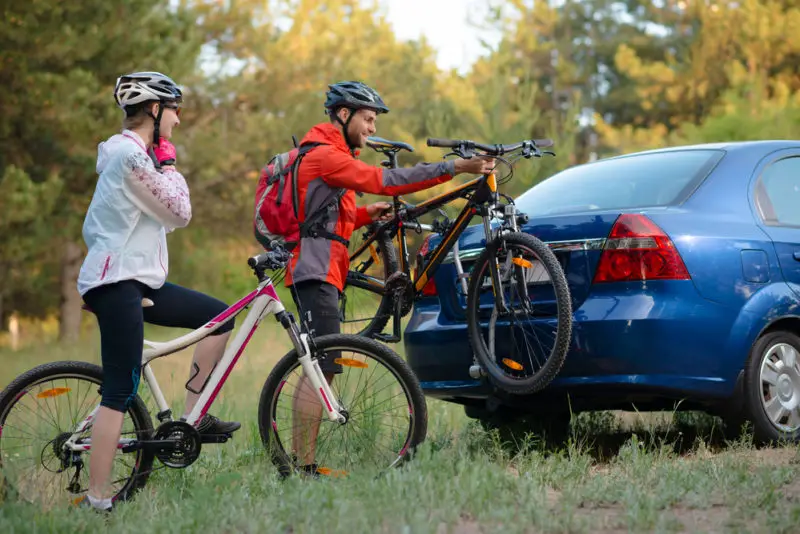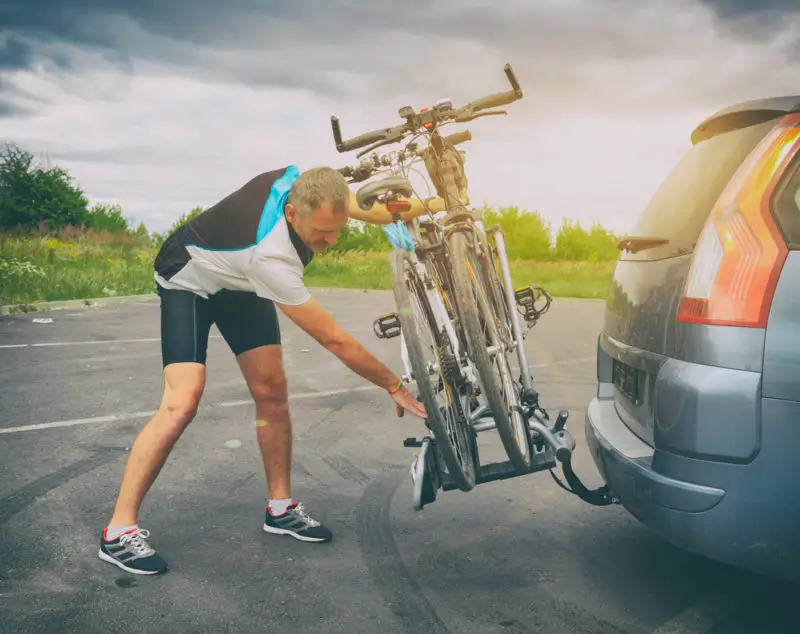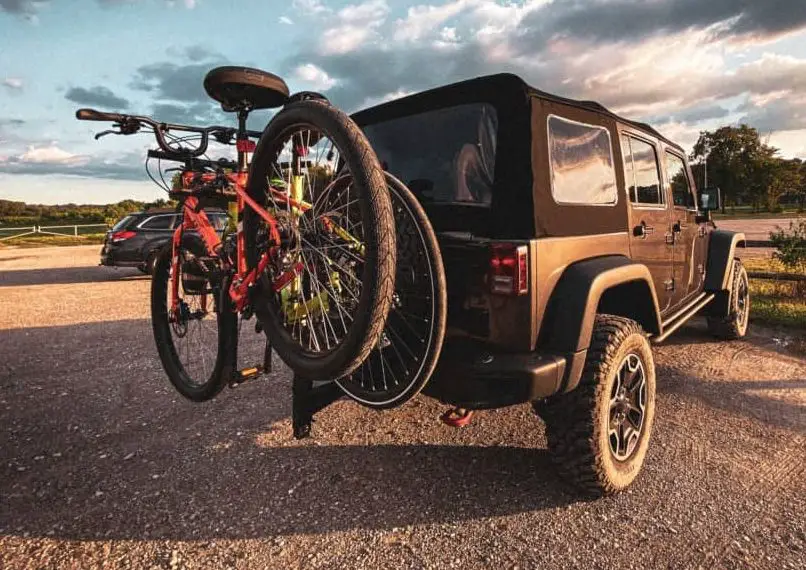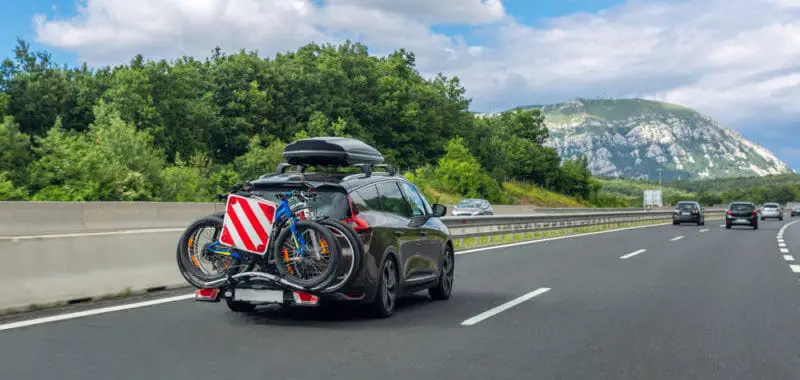I’ve been searching for the perfect bike rack that’s compatible with both my car and my bicycle. But when I started researching bike racks, I ended up with more questions than answers! There are many different types of racks, but are any or all of them safe?
Bike racks are safe when installed correctly on the vehicle. You just need to remember to account for the rack while driving…especially while backing up and parking! Bikes are usually safe on bike racks when they are secured and locked to the rack correctly and when the vehicle is driven carefully.
Whether you drive on country roads or highways, the risk of damage (or theft) is pretty low so long as your rack and bike are properly secured and locked into place.
This article will help you ensure your bike rack and bikes will stay where they should no matter the situation.
Are Bike Racks Secure (Is Theft Likely?)

It really isn’t likely for bike racks to be stolen off of a car, but it does happen. If the right opportunity arises, someone might just make off with your shiny new bike rack. Bike rack theft is more likely to happen in remote locations where there isn’t a lot of traffic…or witnesses.
Most of the time, if you are parked in a public place, a thief isn’t going to take the chance of removing the rack from your car, moving it to another vehicle, and then driving away. It would be pretty suspicious to see someone removing a whole bike rack in a parking lot or at a trailhead, so this is a pretty good deterrent against theft in these areas.
Bike racks are often specific to the vehicle you are driving, so the market for stolen bike racks is a little more specific as well. Though it wouldn’t be too difficult to find an interested buyer online, it may not be worth the time and effort for a thief. Not to mention, the biking community is very tightknit: if your rack gets stolen, it’s possible another rider might see it posted for sale and could alert you.
Are Bike Racks Easy to Steal (Is It Common?)

Bike racks are typically pretty large and cumbersome, so it isn’t that easy to just remove a rack from the car and walk away with it without being noticed.
Roof racks are probably the most challenging type of rack to remove and the most obvious since you have to reach on top of the vehicle to get them down.
Trunk racks are also challenging to remove because you need to open the trunk to take the rack off the vehicle. Breaking into a car exposes a thief to more unwanted attention, so this may not be an option. A thief could cut the straps that hold the rack to the car, but that would damage the rack and make it unusable.
And while hitch racks are the easiest to take off the vehicle, they are the heaviest of all types of bike racks, so it isn’t easy to just walk away with one. And many hitch racks do feature locking bolts, which secure them to the hitch and require a key to open.
Do People Steal Bikes off of Bike Racks?

It is probably much less noticeable to take a bike from a bike rack than take the entire rack. If your bike isn’t locked to the rack, a thief could quickly and easily remove the bike and ride off when no one is looking. If you have an expensive bike, your bike is definitely at risk, and the loss would certainly be devastating.
Never leave your bike unattended on your bike rack and always use a lock. Although locks aren’t foolproof, they are a deterrent, especially if a would-be thief is in a hurry to get away with your bike. So to be safe, always lock your bicycle to the rack on your car.
Be sure not to just thread the lock through the front wheel, which could be easily removed from the fork. Always wrap the bike lock through the frame and then around the bike rack.
How to Lock Your Rack (and Bikes) to Your Car
There are several different methods for locking your rack to your car. A hitch rack can be secured with a locking hitch pin. Some rack models come with one built into the rack.
For a trunk rack, you can use something like the Thule Passive Lock Strap. You loop the end of the strap through the frame of the rack and put the other end into the trunk of the vehicle. This type of lock keeps the rack from being pulled off of the car without opening the trunk.
Use a Cable Lock to Lock Your Bike to the Rack
To lock your bike to the rack, one of the easiest ways to do this is to use a cable lock. Although cables can easily be cut with a bolt cutter, it does require more planning for the thief to accomplish. And it makes a good deterrent, buying you time for someone to notice the thief’s behavior before they make off with your ride.
You will want to loop the cable through the frame, the wheels, the saddle rails, through a tow hook on your vehicle…basically thread it through as many parts of your bike and bike rack as possible before locking. Weaving the cable through the various parts of the bike will keep someone from dismantling the bike in order to steal the frame.
Use a U-Lock to Lock Your Bike to the Rack
You can also use a u-lock to lock the bike frame to the rack. Whenever possible, use a lock that is rubber-coated so that it will not scratch the bike.
Are Bike Racks Safe for Highway Driving?

Bike racks are safe for highway driving as long as they are correctly installed and you drive safely.
Always check your rack and your bikes to make sure they are correctly secured before driving. Give yourself extra starting, stopping, and turning space when driving because the weight of the bikes might affect how your car handles, especially if it is a smaller car or the bikes are very heavy.
You might feel wind drag if your bikes are on a roof rack. You might also feel some wobble if your bikes are on a hitch rack. However, a little bit of rack movement is normal as long as everything is secured correctly. If you think your rack is wobbling more than it should, see our previous article on how to fix a wobbly rack.
Also remember: with a hitch rack, your car is now a couple feet longer than normal, and if you have a backup camera, it’s most likely obstructed. Be extra cautious backing up!
Make Sure Your Bike Rack is Attached Properly
If your bike rack is not installed correctly, you could possibly damage the rack, your bike or your car. First, make sure you have the correct rack for your vehicle. Next, make sure it is installed according to the manufacturer’s directions. Checking the user manual is critical because every rack may have different installation requirements.
You also need to make sure the bikes are installed correctly onto the rack and everything is fastened securely. It won’t be safe to drive if it isn’t attached correctly, no matter how fast or slow you go.
How Fast Can You Drive with a Bike Rack?
Outdooralive.com states that a general speed limit for driving with a bike rack on the highway is 70 to 80 mph. However, they also point out that you should check your owner’s manual because every bike rack manufacturer may have its own specific speed limits. But since few roads have speed limits greater than 70 anyways, this shouldn’t be an issue!
When it doubt, take it easy and drive a little slower than you normally would. Check your rack and bikes often to make sure they are still attached, and always watch out for underpasses and bridges if you have a roof rack. Be extra cautious of your car’s increased length with a trunk or hitch rack while changing lanes or making turns.
I know you’re excited to get to your favorite park or trailhead, but speeding may cost you a damaged bike, rack or a ticket!
Watch Your Clearance for Roof Racks
One of the biggest causes of damage to bikes, racks, and vehicles is misjudging the clearance of your roof rack or forgetting that your bike is on top of your car. If your bike is installed on your roof rack, you’ll need to be extra careful about going under bridges, parking in a garage, and hitting the drive-through after a hard ride.
If you try to drive into your garage with the bike on the roof, you’ll damage the bike, the rack, the car, and probably your garage as well! For this reason, you need to be extra careful when you use a roof rack whether parking or driving.
Give Extra Distance for Trunk / Hitch Racks
If you use a trunk rack or hitch rack, the bike will be sticking out behind the car further than you think. So as you drive, you’ll need to allow yourself a greater distance behind you to avoid hitting something.
When you pull into traffic or merge onto a highway, you’ll need to give extra distance for the car coming up behind you so that it doesn’t run into your bikes. Likewise, you’ll need to make wider turns so you don’t accidentally sideswipe something with your bikes and rack.
Do Car Bike Racks Damage Bikes?
Car racks can cause damage to bikes. If your bikes aren’t installed on the rack properly, they can fall off, move too much, or bang into the car and get damaged. You can prevent this by making sure both the bikes and the rack are correctly installed.
Carbon Bikes May Be More Easily Damaged on a Bike Rack
If you have a carbon bike, a rack that holds the bike by gripping the frame can cause damage to the carbon, possibly scratching or even cracking it. Additionally, if your bike rack holds your bike too close to the exhaust pipe, the heat from the exhaust can damage a carbon frame.
Sloped Top Tubes Can Be Difficult to Attach Safely
Some racks (like trunk racks) clamp onto the bike’s top tube to hold them in place. However, if you have a bike with a sloped top tube or ride a step-through bike, you won’t be able to attach your bike to this type of rack. Your bike will not be able to hang from the rack in an upright position like it’s meant to, which could put added stress on the bike or the rack.
Also, if you are carrying more than one bike on a bike rack, the bikes can become damaged if they bang into each other while you are driving. You’ll need to make sure that the bikes are secured separately and don’t touch.
The Bike Rack Most Likely to Damage Your Bike
A trunk rack is the most likely type of rack to damage your bike. A trunk rack is more likely to cause damage because most trunk racks hold the bike from the top tube. As a result, the bike has room to wobble and may bang against other bikes on the rack. This type of rack may also put too much stress on a carbon frame.
If you use a trunk rack or a hitch rack, make sure that the bike does not hang in front of or near the car’s exhaust pipe. The heat from the exhaust can cause damage to your wheels or frame, especially if they are made of carbon.
These types of racks are also more likely to obstruct your view out the rear window and are more at risk of being damaged if you get rear-ended by another driver.
A roof rack can damage your bike if you forget it’s there and you drive under a low bridge, into a garage or drive-through. You can seriously damage the bike, the car, the rack, and the building. But as long as you remember it’s there, your bike is much less likely to get damaged than with a trunk rack.
Do Car Bike Racks Damage Cars?
Bike racks can damage cars if they are not installed correctly. Any amount of movement can cause scratching, rubbing, or even dent the outside of the vehicle. Therefore, you always need to make sure your rack is installed correctly and moves as little as possible.
You also need to check that you are using the correct rack for your vehicle. Some racks are specifically designed to only fit certain vehicle models…using the wrong rack can damage your car.
The Bike Rack Most Likely to Damage Your Car
Trunk racks are the type of rack most likely to damage your car. A trunk rack maintains contact with the exterior of your vehicle at all times. If it isn’t secured correctly, the rack can scratch the paint or dig into the car’s frame. If the bike isn’t strapped to the rack correctly, it can also bang against the rear of your car, causing further damage.
